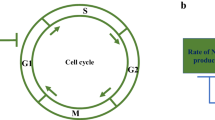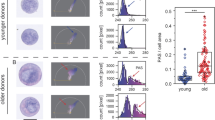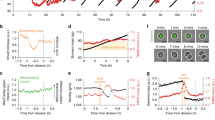Abstract
GLYCOLYSIS, for most mammalian cells, is only a prelude to the complete respiratory oxidation of glucose. Lactate production is usually barely, if at all, detectable in aerobic conditions1. Consequently, when Warburg2,3 observed that various tumours showed active aerobic glycolysis, he postulated that defective tumour cell respiration was the reason and was, moreover, the basic difference between normal and cancer cells. Although aerobic glycolysis by tumour tissue has been confirmed many times, defective respiration in cancer cells has not been established4. The failure to uncover a respiratory defect in cancer cells has led to other explanations. It has been suggested, for example, that aerobic glycolysis is linked to cell growth rather than to malignancy5, and for several hepatomas a correlation could be made between the amount of lactate produced and the cell doubling time6,7. It follows that if aerobic glycolysis is related to cell growth, it might be possible as much in normal as malignant cells. There is some evidence for this. Aerobic glycolysis has been noted in proliferating fibroblasts during the period of maximum increase in cell numbers8,9. Human lymphocytes have shown an increase in respiration and also produced lactate when stimulated by the mitogen phytohaemagglutinin10,11. In chick embryo and skeletal muscle fibroblasts12,13, glycolysis increased during log phase growth, but several factors seemed to influence lactate production. Medium composition, aggregation state of cells, culture pH and cell density were all considered more important in determining glycolytic activity than growth rate. It should be noted, however, that these factors are also important to the proliferative rate of these cells. We believe that the important question is not whether culture conditions can influence lactate production, but rather whether glycolysis is linked to cell division. So far no systematic study of the relationship of the appearance of aerobic glycolysis to cell proliferation or the phases of the cell cycle has been reported. This report presents evidence in normal lymphocytes that aerobic glycolysis not only is associated with cellular proliferation, but more specifically is temporally related to DNA synthesis.
This is a preview of subscription content, access via your institution
Access options
Subscribe to this journal
Receive 51 print issues and online access
$199.00 per year
only $3.90 per issue
Buy this article
- Purchase on SpringerLink
- Instant access to full article PDF
Prices may be subject to local taxes which are calculated during checkout
Similar content being viewed by others
References
Aisenberg, A. C., in The Glycolysis and Respiration of Tumors. 12–13 (Academic, New York, 1961).
Warburg, O., Posener, K., and Negelein, E., Biochem. Z., 152, 309–344 (1924).
Warburg, O., Science, 123, 309–314 (1956).
Weinhouse, S., Adv. Cancer Res., 3, 269–325 (1955).
Markert, C. L., in The Chemical Basis of Development (edit. by McElroy, W. D., and Glass, B.), 623–624 (John Hopkins University Press, Baltimore, 1958).
Sweeney, M. J., Ashmore, J., Morris, H. P., and Weber, G., Cancer Res., 23, 995–1002 (1963).
Burk, D., Woods, M., and Hunter, J., J. natn. Cancer Inst., 38, 839–863 (1967).
Munyon, W. H., and Merchant, D. J., Expl Cell Res., 17, 490–498 (1959).
Steck, T. L., Kaufman, S., and Bader, J. P., Cancer Res., 28, 1611–1619 (1968).
Cooper, E. H., Barkhan, P., and Hale, A. J., Br. J. Hematol., 9, 101–111 (1963).
Roos, D., and Loos, J. A., Expl Cell Res., 77, 127–135 (1973).
Harris, M., in The Chemical Basis of Development (edit. by McElroy, W. D., and Glass, B.), 596–623 (Johns Hopkins University Press, Baltimore, 1958).
Bissell, M. J., Hatie, C., and Rubin, H., J. natn. Cancer Inst., 49, 555–565 (1972).
Ling, N. R., and Kay, J. G., in Lymphocyte Stimulation, 304–326 (Elsevier, New York, 1975).
Loomis, M. E., J. Lab Clin. Med., 57, 966–969, (1961).
Wu, R., Analyt. Biochem., 7, 207–214 (1964).
Gunther, G. R., Wang, J. L., and Edelman, G. M., J. Cell Biol., 62, 366–377 (1974).
Paul, J., in Cells and Tissues in Culture, 1 (edit. by Willmer, E. N.), 239–276 (Academic, New York, 1965).
Bissell, M. J., White, R. C., Hatie, C., and Bassham, J. A., Proc. natn. Acad. Sci. U.S.A., 70, 2951–2955 (1973).
Andersson, J., and Melchers, F., Proc. natn. Acad. Sci. U.S.A., 70, 416–420 (1973).
Vonderhaar, B. K., and Topper, Y. J., J. Cell Biol., 63, 707–712 (1974).
Takahashi, M., Yagi, Y., Moore, G. E., and Pressman, D., J. Immun., 103, 834–843 (1969).
Author information
Authors and Affiliations
Rights and permissions
About this article
Cite this article
WANG, T., MARQUARDT, C. & FOKER, J. Aerobic glycolysis during lymphocyte proliferation. Nature 261, 702–705 (1976). https://doi.org/10.1038/261702a0
Received:
Accepted:
Published:
Issue Date:
DOI: https://doi.org/10.1038/261702a0



